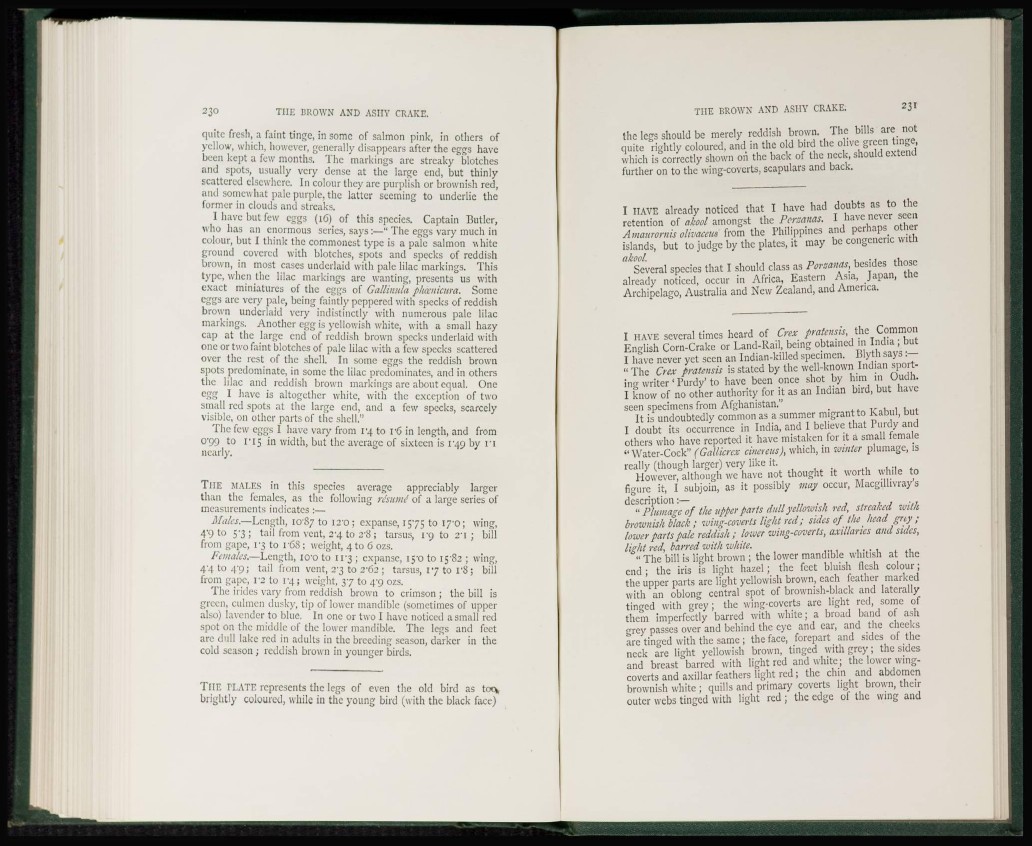
quite fresh, a faint tinge, in some of salmon pink, in others of
yellow, which, however, generally disappears after the eggs have
been kept a few months. The markings are streaky blotches
and spots, usually very dense at the large end, but thinly
scattered elsewhere. In colour they arc purplish or brownish red,
and somewhat pale purple, the latter seeming to underlie the
former in clouds and streaks.
I have but few eggs (16) of this species. Captain Butler,
who has an enormous series, says:—" The eggs vary much in
colour, but I think the commonest type is a pale salmon white
ground covered with blotches, spots and specks of reddish
brown, in most cases underlaid with pale lilac markings. This
type, when the lilac markings are wanting, presents us with
exact miniatures of the eggs of Gallinula phienicura. Some
eggs are very pale, being faintly peppered with specks of reddish
brown underlaid very indistinctly with numerous pale lilac
markings. Another egg is yellowish white, with a small hazy
cap at the large end of reddish brown specks underlaid with
one or two faint blotches of pale lilac with a few specks scattered
over the rest of the shell. In some eggs the reddish brown
spots predominate, in some the lilac predominates, and in others
the lilac and reddish brown markings arc about equal. One
egg I have is altogether white, with the exception of two
small red spots at the large end, and a few specks, scarcely
visible, on other parts of the shell."
The few eggs 1 have vary from I'4 to r6 in length, and from
O'oo to i• is in width, but the average of sixteen is 149 by I 'l
nearly.
THE MALES in this species average appreciably larger
than the females, as the following resume of a large scries of
measurements indicates :—
Males.—Length, lO'Sy to I 2 ' 0 ; expanse, 1575 to I7'0; wing,
4'9 to 5'3 ; tail from vent, 2*4 to 2*8; tarsus, 1-9 to 21 ; bill
from gape, ['3 to I 'GS ; weight, 4 to 6 ozs.
Females.—Length, 100 to 11 3 ; expanse, I5'0 to I5'S2 ; wing,
4 4 t 0 4'9; tail from vent, 23 to 262 ; tarsus, 1 7 to 1'8; bill
from gape, I'2 to 1 4 ; weight, 37 to 4"9 ozs.
The hides vary from reddish brown to crimson ; the bill is
green, oilmen dusky, tip of lower mandible (sometimes of upper
also) lavender to blue. In one or two I have noticed a small red
spot on the middle of the lower mandible. The legs and feet
arc dull lake red in adults in the breeding season, darker in the
cold season; reddish brown in younger birds.
THE TLATE represents the legs of even the old bird as tot*
brightly coloured, while in the young bird (with the black face)
the legs should be merely reddish brown. The bills are not
quite rightly coloured, and in the old bird the olive green tinge,
which is correctly shown oh the back of the neck, should extend
further on to the wing-coverts, scapulars and back.
I HAVE already noticed that I have had doubts as to the
retention of akool amongst the Porzanas. I^ f^
Amaurornis olivacem from the Philippines and perhaps other
islands, but to judge by the plates, it may be congeneric with
^Several species that I should class as Porzanas, besides those
already noticed, occur in Africa, Eastern Asia, Japan, the
Archipelago, Australia and New Zealand, and America.
I HAVE several times heard of Crex pratensis, the Common
English Corn-Crake or Land-Rail, being obtained in India ; but
I have never yet seen an Indian-killed specimen. Blyth says :—
" The Crex pratensis is stated by the well-known Indian sporting
writer ' Purdy' to have been once shot by him in Oudh.
I know of no other authority for it as an Indian bird, but have
seen specimens from Afghanistan."
It is undoubtedly common as a summer migrant to Kabul, but
I doubt its occurrence in India, and I believe that Purdy and
others who have reported it have mistaken for it a small female
"Water-Cock" (Gallicrcx cineteus), which, in winter plumage, is
really (though larger) very like it.
However, although we have not thought it worth while to
figure it, I subjoin, as it possibly may occur, Macgillivray's
description :—
" Plumage of the upper parts dull yellowish red, streaked with
brownish black ; wing-coverts light red; sides of the head grey ;
lower parts pale reddish ; lower wing-coverts, axillarics and sides,
light red, barred with white.
" The bill is light brown ; the lower mandible whitish at the
end ; the iris is light hazel ; the feet bluish flesh colour;
the upper parts are light yellowish brown, each feather marked
with an oblong central spot of brownish-black and laterally
tinged with grey; the wing-coverts are light red, some of
them imperfectly barred with white; a broad band of ash
grey passes over and behind the eye and ear, and the checks
are tinged with the same ; the face, forepart and sides of the
neck are light yellowish brown, tinged with grey; the sides
and breast barred with light red and white; the lower wingcoverts
and axillar feathers light red; the chin and abdomen
brownish white ; quills and primary coverts light brown, their
outer webs tinged with light red ; the edge of the wing and